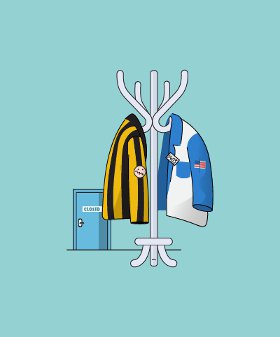More than 25 years of trend following
In a continuously evolving world, it is our ambition to keep on adapting.

In a continuously evolving world, it is our ambition to keep on adapting.

In 1987, Transtrend started as a research project, focused on identifying trading opportunities in commodity futures markets. This project ultimately resulted in a diversified trend following trading program – our Diversified Trend Program (DTP). The world we live in right now is not the same as the world we lived in around 1990. The developments since then have required many changes to our way of trading. But at the same time, they also offered many new opportunities. The track record of DTP is the footprint of our maneuvering through all these developments.
Markets change. The world changes. The world has always been changing. When we started Transtrend in the late eighties, smart phones did not exist. Not even mobile phones. Internet and email were still in their infancy, only used by a small group of scientists at universities. When we were interested in the contract specifications of a futures contract, we had to call the exchange using a landline telephone and ask for a brochure to be sent to us by post. It would arrive after a few days. In our office, we had bookshelves loaded with such brochures.
Computer processing power was scarce. Our huge computer platform back then had less processing power than a modern smartphone. The calculations we nowadays process in a few minutes would have cost us a whole day back then – the markets would already have been closed before we would have determined what we wanted to trade. For this reason, the amount of data we used had to be limited. For research purposes, we did not have tick data available, only end-of-day transaction data: an opening price, the high and the low of the day, the close and/or daily settlement, the daily volume and the (previous) end-of-day open interest.
Trade execution was done by human open outcry on exchange floors. We were not standing there in the pits, so we did not have direct access. To trade an Australian market, we called an Australian broker and worked our orders through them. To trade a Japanese market, we called a Japanese broker. To trade a Malaysian market, we called a Malaysian broker. And so we made a round of telephone calls around the world every day. The fills on our orders were communicated verbally by phone. At the end of the day, we received a transaction and position overview from every broker by telex or telefax. The official account statements were sent by post; every day a mailbag full of envelopes was dropped on our doormat.

One of the world’s most liquid interest rate futures contracts was on U.S. T-bills traded on the International Monetary Market in Chicago. One of the world’s most liquid commodity futures contracts was on Azuki red beans traded on the Tokyo Grain Exchange. Both of these futures contracts are barely traded anymore. When we started trading Nasdaq futures, one of our clients inquired why we should trade such an obscure contract. We replied: maybe it grows. When we started trading the Korean Monetary Stabilization Bond: same question, same reply.

Sometimes we were right, sometimes not. From the approximately 70 (outright) markets we traded in DTP before 1995, one out of seven we do not trade anymore. Some of these markets do not exist anymore. Of the approximately 600 (outright) markets we currently trade with DTP, less than one out of seven existed before 1995. Fortunately, we did not have to tell our clients back in 1995 that we planned to start trading non-existing concepts like the ‘euro’, or ‘emission rights’ or ‘volatility’. They would have thought we had been hit by a windmill. Since then, numerous new futures contracts on much less exotic markets have come and gone.
The vast majority of the synthetic market combinations we trade right now were practically impossible to trade before 2000. Trading these market combinations requires the parallel execution of the two legs on two different exchanges, often on different continents.
Back then, DTP was a global diversified trend following program. Which it still is.
Much more has not changed. Such as the continuous emerging of new CTAs. This is a healthy development in a continuously changing world. We ourselves once were such an emerging CTA. Hundreds of us start every year. Some of us become successful; most of us do not. It follows a standard procedure: a group of persons starts to trade futures markets – for their own account or seeded by people or an organization that have high expectations of these new traders. From this trading, a track record emerges. And when other investors get enthusiastic about that track record, they will start to invest with this rising CTA.
There is one value emerging CTAs have always shared: we all think that we are doing things differently. In that respect, a new development in the past decade has been the emerging of managed futures investment managers who call themselves ‘replicator’. In itself, this term is somewhat strange when it is linked to an activity. You can replicate a painting by Van Gogh. But you could not have been replicating Van Gogh, meaning you could not have been painting Van Gogh’s next painting at the moment that Van Gogh was painting it. That could only have been done if Van Gogh would have been painting the same painting over and over again. CTA-replicators essentially suggest that CTAs with a successful, live track record have been doing, and will continue to do, the same thing over and over again. Which at least in the past was impossible. The world simply has changed too much for that.
Historical simulations are performed with the knowledge of hindsight, using current technology and assuming current infrastructure. In other words, assuming a non-changing world with non-changing markets.
CTA-replicators are not driven by having a view on the markets traded, but by a commercial concept that allows them to capitalize on the historical performance of successful CTAs and gives them an excuse to use simulated returns. The trick is simple. You backtest one, or a combination of publicly available momentum strategies on a selected portfolio of markets. You call the outcome of these simulations an index. So you do not show simulated returns – you show the returns of an index. The next step is to show that the (average) historical performance of actual CTAs is correlated with the returns of this index, suggesting that these CTAs have effectively been offering some version of this index. This is a crucial step: if there would not have been any actual track records that seem to support the validity of the created index, no investor would be interested in investing in this index. The final step is offering this index, claiming that you are able to generate an actual performance that is close to the returns of the index. This is of course the easiest step, given that you have defined the index yourself. The priority of the replicator is to deliver the returns of this index. Whether these returns will continue to be attractive is of secondary concern.
You can call simulated returns an index, but they still remain what they are: the outcome of historical simulations. Meaning: with the knowledge of hindsight, using current technology and assuming current infrastructure. Any investment manager who actually produced strong trading results in the period 2009-2015 has shown that they have been very capable in dealing with the market environment in those years. Nothing more, nothing less. Past performance is not an indicator of future results. But past non-performance is a 100% guarantee of past no returns. Anyone who has not actually delivered the crisis alpha in 2007/2008 and in similar periods further back in time, should not suggest that they would have delivered this crisis alpha if they would have offered their strategy. They should instead explain why they did not offer this strategy in those years. One of the arguments we often hear is “because these (trend following) techniques were not publicly available back then”. This is of course nonsense. Trend following techniques were already described in the utmost detail in, for example, the books of Welles Wilder and John J. Murphy, both published before 1990 and available to everyone. Granted, it was not available on internet back then. To get these books in the eighties, you had to call a bookstore using a landline telephone, asking for a copy to be sent to you by post.
In the CTA space there is not that much money invested with these replicators. But the underlying belief that the historical returns actually delivered by various CTA-strategies can easily be reproduced by just a systematic application of publicly available time series momentum strategies – essentially undermining the art of trend following – has spread widely beyond the replicators’ audience. And the ‘evidence’ supporting this belief also primarily consists of simulations, performed with the knowledge of hindsight, using current technology and assuming current infrastructure. In other words, assuming a non-changing world with non-changing markets.
The reality is, there has never existed a simple, technical trading rule that can be applied year after year after year consistently generating profits.
The question whether or not successful trading can be taught and replicated by just learning a set of simple rules is not new. Famous is the ‘Turtle’ experiment in the early eighties. Two successful traders, Richard Dennis and William Eckhardt, recruited more than 20 persons with various backgrounds. After a two-week training period, each of them received a trading account in order for them to show what they had learned. The story went that all of them were very successful, making millions of dollars of profits. In reality, only a few of them were successful. The story went that those who were not successful failed because they did not stick to the rules that had been taught to them. In reality, the Turtles who continued to be successful admitted that they themselves did not stick to the rules, but instead adapted their trading. Ultimately, their success did not come from strictly following a secret set of rules, but from following certain general principles and having the mentality required to keep on doing well.
The story went that there was a bet between Dennis and Eckhardt – Dennis claiming that trading could be taught and Eckhardt claiming that it could not. According to that story, Dennis was the winner. But there probably was no bet. At least, Eckhardt denies there ever was. But if there would have been a bet, we would announce Eckhardt the absolute winner. Dennis’ trading did not survive the market volatility in 1987. Eckhardt, on the other hand, continues to be a very successful trader, and at least as successful as the Turtles he has trained. He demonstrated this again in 2016. In a 2011 interview¹, Eckhardt said that he is still doing the same thing, but that there is not one part of his systems that has not been modified.
Stories can be powerful. But the reality is, there has never existed a simple, technical trading rule that can be applied year after year after year consistently generating profits. Nor a secret rule only known by a few insiders, nor a publicly available rule acclaimed by academics. And we are convinced that such a rule will never exist. The world continuously changes. Markets continuously change. And any investment strategy that does not adapt to these changes will experience diminishing performance. This is one of the few rules that has not changed. It is our ambition to keep on adapting. If only because we realize that only by adapting, we can continue to offer effective trading programs.
¹ Futures Magazine – March 2011 issue.